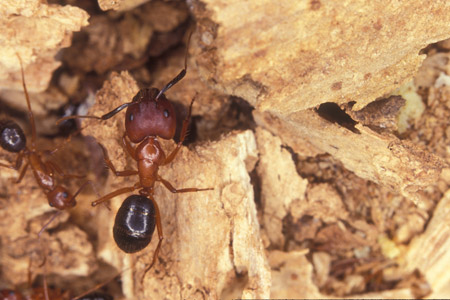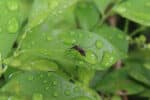
How Are Ants Getting in the House?
Besides cockroaches, ants can be the most common insect pest problem in many South Florida homes. Knowing how to identify the different types of ants, where they hide, what they feed on, and the conditions they like, can help you as the homeowner prevents ants from invading. However, some types of ants have very large colonies, and these stubborn ants often require treatment by a professional pest control company. Don’t wait until the bugs have completely taken over your home to have your house professional treated.
While there are more than 10,000 species of ants found across the globe, there are just a handful that frequently invade homes in South Florida, causing annoyance and irritation to homeowners. Of these handful of ant pests, four types of ants can be particularly troublesome in South Florida:
- Big Headed Ants
- Ghost Ants
- White Footed Ants
- Carpenter Ants
If you notice that ants have made their home in your residence, you must seek help from a professional bug control service as soon as possible. Attempting to treat an infestation on your own may not fully eradicate the problem and may lead to a lingering issue or growing infestation.
The first step to prevent infestation, other than a recurring pest control program, is to understand the signs of infestation, and what you can do as the homeowner to decrease your ant pressures, before an infestation gets out of control.
Common Ants Infesting in South Florida
Four types of ants that homeowners are likely to discover infesting their homes in South Florida are Big Headed Ants, Ghost Ants, White Footed Ants, and Carpenter Ants. They each have their own unique biology, food choice, nesting qualities, appearance, and foraging behavior. It is crucial to correctly identify the type of infesting ants in order to most effectively treat the nest and protect your home.
Big Headed Ants
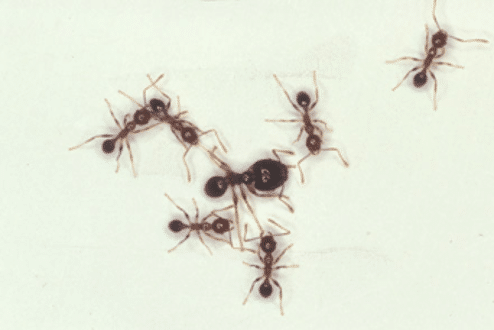
Big Headed Ants are an invasive species that are common in subtropical climates, like we have here in south Florida. They can be particularly difficult to control due to a single colony having multiple queens, reproducing year-round. Often, multiple colonies can completely take over a landscape, across multiple property lines. Big Headed Ants are soil-nesting ants that have a mixed diet between other small insects, and sweet honeydew found in the landscape. Big Headed Ants are named because they are dimorphic, meaning they have both a major and minor worker that are two different sizes. The major worker is equipped with a very large head, much larger than its body, hence, the “Big Headed Ant”.
Big Headed Ants are known for making large nests in the sand throughout the landscape and excavating soil and bringing it up through cracks in driveways, patios, and pavers on the exterior of homes. Sometimes in severe cases, Big Headed Ant colonies can nest under concrete slabs, and invade your home, similar to termites, and can even excavate soil into the interior of the home through baseboards. Because of this subterranean habitat and their tendency to create piles and foraging tubes made of sand and debris, sometimes Big Headed Ants can be misidentified as subterranean termites.
Although these ants aren’t associated with directly causing structural damage to a home, they certainly can make a mess on the interior, and damage the aesthetics and functionality of the landscape. Plus, no one likes the idea of having creepy crawlers in the space where their family and guests lounge, sleep and eat.
How to Get Rid of Big Headed Ants
Big Headed Ants burrow into the soil to create their nests, but usually make their way into your home when they’re on the hunt for food. What’s more, where there is one Big Headed ant nest, there are often several. They are rarely an isolated occurrence, due to the widespread nature of their homemaking. Big Headed Ants are known for building “super colonies,” a series of smaller colonies that are connected for them to move between freely, carrying food to other colony members. This can make them particularly difficult to control.
For all of these reasons, professional pest control is usually needed. If you notice foraging trails or tubes on the sides of trees, or on the exterior of your home, or nesting sites in sand or soil patches in the landscape, in a somewhat conical shape, contact Hulett Environmental Services right away. If a Big Headed Ant nest is nearby, you may have “workers” or “crawling ants” foraging into your home through cracks and crevices to feed on food remnants of meat, grease, liver, molasses, peanut butter, pet food, fruit and fruit juices, etc.
Thus, kitchens and storage cabinets are prime spots for these reddish-brown ants to appear. Hulett Environmental Services will complete a free inspection and inspect all of these areas and discuss with you the best course of action to get rid of Big Headed Ants from your home.
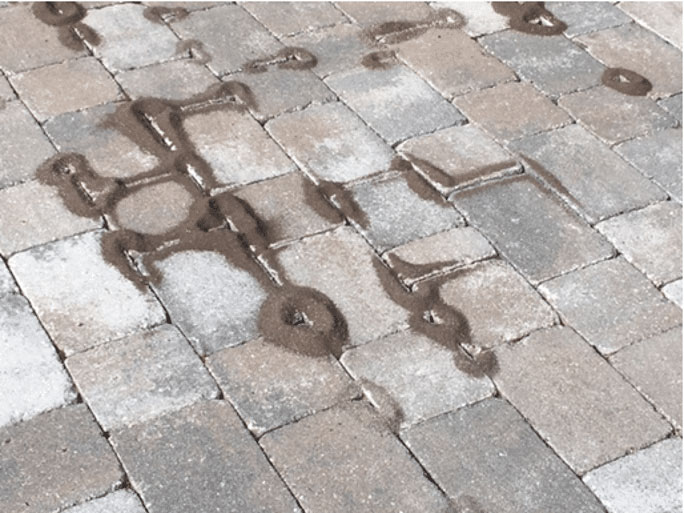
Ghost Ants
Ghost Ants are tiny. They are just 1.3 to 2 millimeters in length. They can be identified by their dark colored heads and thorax, and their translucent legs and abdomen. Their small size and coloration make them difficult to see, hence the name “Ghost Ant”. These ants prefer tropical climates, making them a widespread, common problem here in South Florida.
While Ghost Ants do not bite or sting humans, they do infest homes. Ghost Ants are found nesting on the exterior of homes, but will invade to feed off of sugary food remnants such as:
- Candy
- Syrups
- Honey
- Cookies
- Cereals
Because of this, Ghost Ants are most commonly found scurrying across your counters, sinks, or inside your cabinets, foraging for these sweet attractants. If you see these tiny ants trailing about, you likely have a Ghost Ant infestation.
How to Get Rid of Ghost Ants
Ghost Ants are particularly irritating because once they invade and find a sweet substance to feed on, they trail and recruit many other ants to feed on the food source. Thus, homes can quickly become infested. If many food sources are available, Ghost Ants may even begin to nest within the home, making getting rid of the ants more problematic. If the Ghost Ants forage into cabinetry and stored food products, homeowners may find themselves discarding valuable groceries. Because of this, it is very important to treat right away, even if you notice just a few ants crawling about, because where there is one, there are undoubtedly more.
There are simple steps that you can begin taking on your own, including cleaning out your cabinets and pantry, throwing out the ants’ food sources and items that they have infested, vacuuming, caulking entry points in gaps between baseboards and windows, and scrubbing the kitchen surfaces with cleaning products.
However, ant nests are often hidden away out of sight and it can be difficult to find them without training. Because of this, it is important to contact a professional bug treatment service to help you correctly identify the ants, locate the potentially many nests on the interior and exterior of the home, and bait and treat accordingly. Hulett Environmental Services will know exactly where to search for the nests and apply a targeted treatment to ensure that the infestation is eradicated, not to return.
Florida Carpenter Ants
Carpenter Ants are another one of the most common types of infesting ants in Florida. Carpenter Ants are very large ants, reaching up to 2.5 centimeters in length and often have a bicolored appearance of orange-brown bodies and a black abdomen. Although they will not sting, they will bite. Carpenter Ants most commonly live in trees but will forage and nest inside of homes if the conditions are right. They commonly build their nests within preexisting voids, or in damp and rotten wood in which they can excavate. They cannot excavate sound wood.
Because of this, Carpenter Ants tend to be located near areas with access to moisture via plumbing, roof, or window leaks. Common nesting places include wooden decks, windowsills, plant beds, tree cavities, structural lumber that has been compromised due to moisture or termites, wall voids, meter boxes, utility boxes, etc.
A Carpenter Ant infestation is usually apparent to homeowners. One reason is because of the large size of the foraging ants. These ants will forage at night, wandering about loosely looking for sweets around the home. One reason Carpenter Ants are difficult to control is that they can make several “Satellite Nests”, infesting multiple areas throughout a home or landscape. It is very important to consult a professional pest control company for treatment of your Carpenter Ant infestation, because in order to eradicate the issue, for good, it is crucial to locate and treat all satellite nests in all of the hidden and hard to reach voids.
If Carpenter Ants are nesting within the home, like termites, they are likely to have numerous “Swarms” that occur by the winged reproductives, attempting to spread the infestation. Although not directly consuming the wood, such as termites, Carpenter Ants will hollow out wood that has been compromised by moisture, and this often creates debris that is frequently misidentified as termite damage. This debris is often the first sign detected by homeowners.
If you notice any of these signs occurring within your home or landscape, contact a pest control service immediately. Hulett Environmental Services will be able to identify whether the activity is related to Carpenter Ants or Termites and develop a plan for how to get rid of your pests.
How to Get Rid of Florida Carpenter Ants
There are several helpful techniques homeowners can use to decrease pressures by Carpenter Ants. Carpenter Ants most often nest within trees located on the exterior of homes. It is very important to trim trees that have branches touching the home, in order to cut off their easy access to invade. Although Carpenter Ants hunt live and dead insects, they will also feed on sugary residues found within the home. Thus, it is very important to keep a clean kitchen. Lastly, because Carpenter Ants require moisture and softened wood to excavate, repairing water leaks and replacing compromised wood can greatly reduce Carpenter Ant activity.
However, because Carpenter Ants are likely to have multiple nesting sites, often in hidden and hard to reach places, a professional pest control operator is most often required to fully eradicate the problem. Hulett Environmental Services has technicians trained by a Board-Certified Entomologist and will be able to locate and treat the nests on the interior and exterior of the home, solving the problem for good. So, call today to have experts utilize their specialty approaches to eradicate your infestation of these pesky bugs.
White Footed Ants
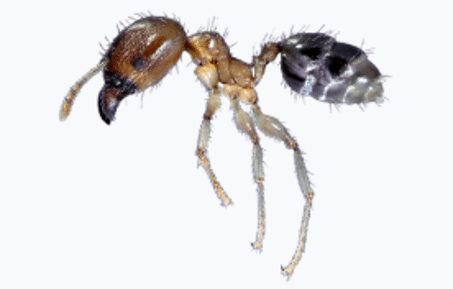
White Footed Ants are also among the most common types of infesting ants in South Florida. They are mainly present in South and Central Florida due to the warm, humid environment. As the name suggests, though they have black bodies, the lower portions of their legs are white in color.
White Footed Ants do not bite or sting, but they are an annoyance to homeowners. They have very large colony sizes and these enormous amounts of ants are frequently found “Trailing” on the exteriors of buildings or invading through cracks and crevices into kitchens and baths, or any area that they may find moisture and sweet residues. White Footed Ants will nest in warm, damp environments, such as:
- Bushes
- Leaf Litter
- Mulch Beds
- Trees
Because of this, they often gain access into attics or second-story homes by tree branches that need pruning. Once they crawl through a soffit vent and into an attic or wall void, nesting may occur in hard to reach places, which can make treatment more difficult.
However, a trained pest control operator will be able to follow these trailing ants in order to find and effectively treat the nests, potentially located on the interior and exterior of the home. Because of the difficulty associated in eradicating these large colonies, a professional pest control company is often required.
How to Get Rid of White Footed Ants
If you have noticed a massive number of black ants with white legs trailing up and down your walls, it is an indication that you have a White Footed Ant infestation. There are some techniques homeowners can complete to decrease White Footed Ant pressures, such as trimming back trees and bushes on the perimeter of their home so that they are not touching the exterior walls or roof, resulting in a White Footed Ant “Highway” or “Bridge” into your home.
Removing wood piles, lawn debris, and grass or leaf cuttings that have accumulated on your lawn will also help reduce pressures by removing suitable nesting environments. Lastly, if you have seen White Footed Ants in the area, make sure to do a thorough cleaning of the kitchen, in order to take away any suitable food sources.
To eliminate your White Footed Ant infestation, it is recommended that you contact a professional pest control service. Hulett Environmental Services can inspect your landscape, find the various areas where ants may be nesting, and bait and treat accordingly.
Preventing Ant Infestations
The various types of ants in Florida are infamous for infesting homes and dwellings, and it is a common problem that everyone will face at one time or another. The abundant food sources inside homes and the ideal environment for nesting are virtually impossible to avoid.
What you can do, after seeking professional bug treatment for an infestation, is take preventative steps to prevent future ant invasions.
Prevention Tips at Home
First, you must take measures to make your home as uninviting to the pests as possible. Keep sugary foods in airtight containers when possible, and always make sure that bags of food remain sealed. Clean up any spills immediately. Do not simply wipe the counters down with a damp sponge. Use a cleaning product that will eliminate the sugar that attracts the ants.
When possible, replace water-damaged wood that types of ants in Florida like to nest in. While you may not be able to remove trees and bushes, you can trim them to keep them from touching your home and acting as “Bridges”.
Professional Ant Prevention
The best course of action when preventing future ant infestations is to hire a professional pest control and lawn care service for regular maintenance. With scheduled maintenance, professionals will be able to spot signs of infestations immediately and take action before they cause you a significant inconvenience and headache to eradicate.
At Hulett Environmental Services, we will complete a free inspection of your home, analyze your various ant pressures, and discuss with you a custom program designed to protect your home from ant invasion. Our environmentally, pet, and family friendly products will keep your home and landscape protected all year-round.
Ask Our Ant Experts
If you believe you may have an ant infestation, by any of the common types of ants in Florida, contact us today. Take action and protect your home. We offer entirely free, no-obligation home inspections to evaluate any pest or bug concerns you may have.
You can also use our online expert portal. You can upload pictures of either insects or suspicious areas for our Entomologist to review. Someone will get back to you within one business day, offering advice on the proper next steps.
Contact us today at 866-611-2847.

